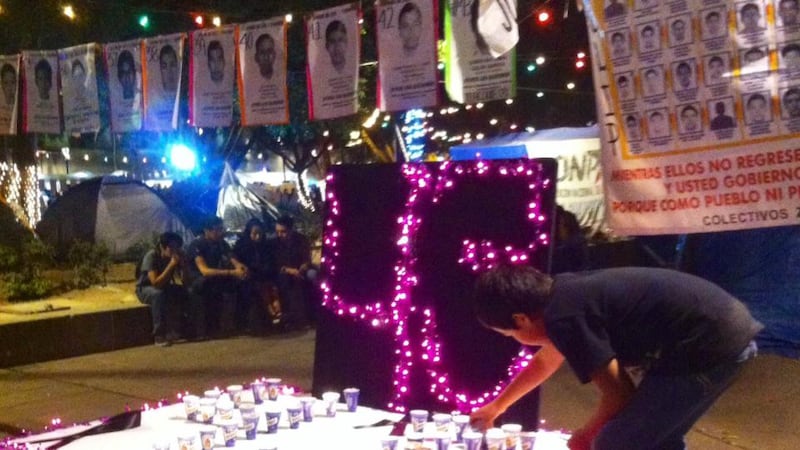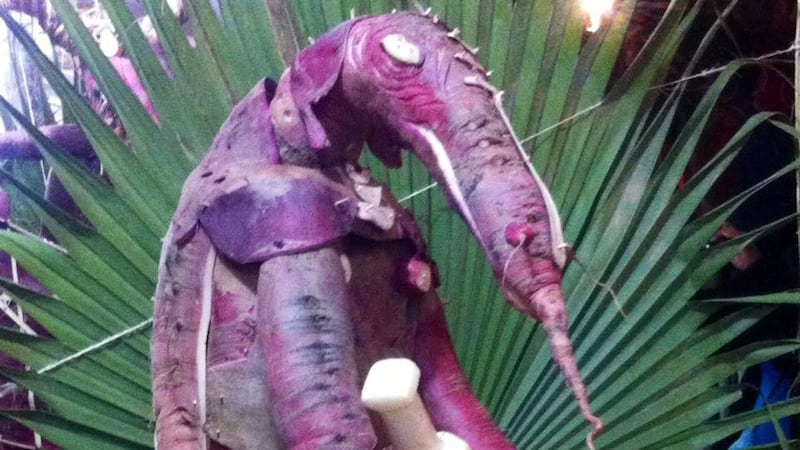A giant flea nursing a bottle of mezcal, a bug-eyed parrot swaying in the evening breeze, a pastoral tableaux and an abundance of nativity scenes - just some of the sculptures that stretch along all four sides of the zócalo (the main plaza in Oaxaca) on the night of December 23rd.
It's the traditional Noche de Rábanos ("Night of the Radishes") when local craftsmen compete in the radish sculpture competition, attracting thousands of visitors to the square. From the length of a child's finger to that of my own forearm the radishes vary hugely in size. For someone more used to experiencing radishes as a crunchy garnish for tacos, the range is astounding.
People queue for hours to get access to the viewing walkway that, for one night only, borders the whole square. A procession of locals and tourists film the bizarre vegetal creations at an achingly slow speed.


Happy to view the sculptures from a less than optimal angle (and, thus, avoid queuing), we duck in through a gap in the railings to get to the interior of the zócalo. While the plaza is ringed in festivity, at its heart lies something vile-a vivid image, the horrifically mutilated face of a young man named Julio Cesar Mondragón.
Protests
Oaxaca is known for its protests. While some other parts of Mexico seem happy to just sit tight and hope for better times or, more commonly, only get worked up about matters that occur within the confines of their own state, Oaxaca wears its disgust at social injustice on its breast.
The first time I visited Oaxaca was in 2009. The zócalo was packed then with members of the APPO (Popular Assembly of the Peoples of Oaxaca) camped out and willing to share their message with anyone who would listen. Media savvy campaigners, they shared photographic and video proof of the oppression (murder) of striking teachers by the state forces.
Now, in the last few months, protestors have re-taken possession of the zócalo to highlight the "disappearance" (probable massacre) of the 43 Ayotzinapa normalistas ("trainee teachers") at the hands of the police in the municipality of Iguala. While the police probably outsourced the "disappearances" to local criminals, they cry of ¡No fue la delincuencia, fue el estado! (roughly translatable as "it wasn't the criminals, it was the state!") has been heard the length and breadth of the country.
In this new world of optimistic (and, it must be said, well meaning) hashtag activism, it comes as no surprise that the incident has sparked outrage, not just all over Mexico, but globally.
Though the Iguala massacre occurred in the neighbouring state of Guerrero, the people of Oaxaca stand in solidarity with their compatriots. From tree to tree, lamp-post to lamp-post, Christmas bunting and lights cover every square inch of the zócalo.
But the bunting, upon closer examination, is not of a festive nature. Each rectangular piece of paper has a name, a number and, crucially, a face - the faces of the deceased normalistas. I am drawn to number 24, Alexander Mora. He looks strong and determined.
Recently, the #nosfaltan43 ('we're missing 43') slogans which have been emblazoned across walls, buses and shop-fronts have been replaced by ones reading #nosfaltan42. You see, one of the 43 normalistas has been identified. A fragment of bone and a molar were identified as belonging to Alexander Mora. One down, 42 to go.
Beside the bandstand I chanced upon that aforementioned image of Julio Cesar Mondragón. A young father who had been studying at the Ayotzinapa teacher training college for just one month, Mondragón, after the group of protesting trainee teachers were fired upon by the local mayor’s outsourced hit-men, fled on foot. His remains turned up the next day.
His corpse seemed untouched but for one detail - his face had been removed. His perfect teeth surrounded by a crimson mess of exposed flesh. The psychological and physiological barriers removed - not a caricature, not a signifier of death, but death itself, real and hideous. His eyes had been scooped out. “What did they do with his eyes?” I muttered out loud and wept like a child. The protestors’ insistence that the normalistas not remain anonymous, not remain faceless, beset by this sickening irony.
Christmas procession
On the night of the 24th, the traditional day for the big family gathering in Mexico, we strolled through the city in the dark. A multitude of brass bands marched through the streets, each trying to drown out the other. This is nothing new in Oaxaca, music and fireworks are a nightly occurrence.
Again, around the zócalo, a huge procession demanded my attention. Trucks with children dressed as figures from the nativity were followed by dancing girls with magnificent skirts and men holding bamboo framed giants with papier maché heads. All danced and twirled, multi-coloured dervishes enraptured in their shared dreams.
Each of the barrios brought their own mojigangas (giants) and their own brass bands. Earlier in the day I’d seen a boy play a sousaphone he’d fashioned from plastic water bottles, begging for cash. I looked for him among the bands but, of course, he didn’t feature.
For a Christmas procession, the instruments were impeccable. Metallic and polished they twinkled in the night. Fireworks exploded everywhere and a rain of sulphur and primary colours bathed us all in its pungent glow. Children everywhere, pregnant girls everywhere and the blank stares of the normalistas in the background - everything exaggerated, the reality of life and death in every blink.
We booked ourselves in for a pricey Christmas dinner in a fancy hotel: prawn bisque with roasted almonds, piping hot turkey with a fruits-of-the-forest sauce, stuffing infused with apricot purée, pears soaked in aniseed and red wine with cinnamon ice-cream.
Outside the noise of the fireworks and parading mojigangas diminished slowly. On the street a little girl played an accordion. I gave her some coins.
Back to the hotel through the zócalo, I squeezed my woman’s hand and started thinking about the 43 empty seats at Christmas dinner tables across Guerrero. Then about the many, many more empty seats throughout the country and further afield. Sure that my mother would miss me at the dinner table in Dublin, I couldn’t begin to imagine what the mothers of Alexander Mora and Julio Cesar Mondragón must’ve been feeling.
Beep. A message on my phone, a news service announcement. Wooden Enrique Peña Nieto (more a haircut than a president) wishes us all a happy Christmas and calls for peace and an end to violence. I put my phone way, I pay no attention to puppets. He, like I, still has his quiff, his face, his eyes. Peña Nieto is famous for being handsome.
A photo of Mondragón with a young lady and a baby in his arms confirms that he too was handsome. Can his loved ones only remember like that? I doubt it. Those 43 have nothing but their names. “Learn them, remember them,” I whispered to myself.
Dylan Brennan is an Irish writer currently based in Mexico. His poetry, essays and memoirs have been published in a range of international journals, in English and Spanish. His debut poetry collection, Blood Oranges, for which he received the runner-up prize in the Patrick Kavanagh Award, is available now from The Penny Dreadful Press. dylanbrennan.org









